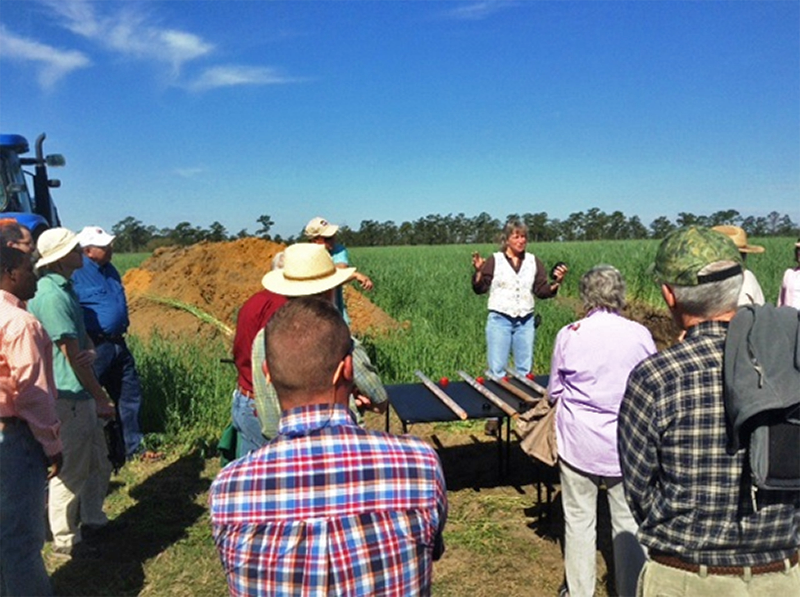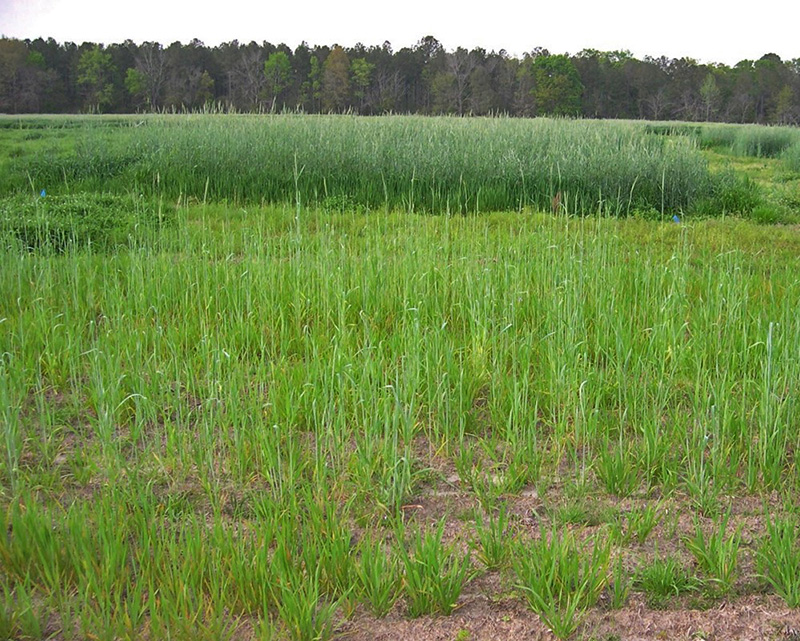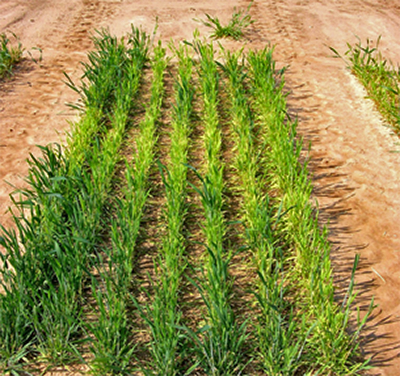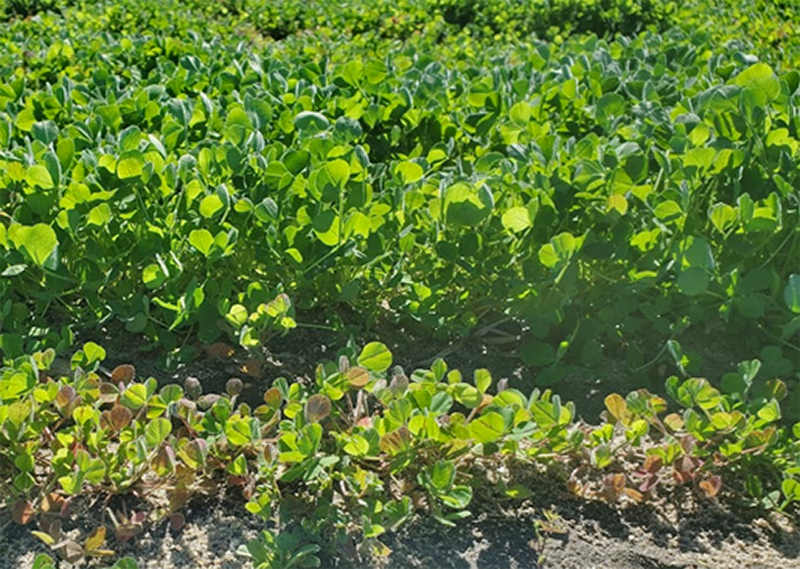Cheryl Mackowiak, UF/IFAS Soil Scientist, Ann Blount, UF/IFAS Forage Breeder, Marcelo Wallau, UF/IFAS State Forage Specialist
Now is the time to begin planting your cool-season annuals. How you manage the soil fertility depends upon the soil type and fertility, which plant species you choose, and whether it will be utilized for grazing, silage, or as a cover crop. These factors will be addressed individually, followed by some consideration of systems-level management.
–
Soil type and fertility influences
Your soil type and surrounding environmental conditions will greatly influence which forage species or systems will be most successful for a particular location. For example, soils in Peninsular Florida (along the Florida Ridge) are the coarsest types, with minimal clay minerals, generally making them low in fertility and excessively droughty. In this instance, large-seeded forage species (winter pea, vetch, cereal rye and triticale) may be the most successful. In comparison, the northern tier of Florida and much of the Southeastern Coastal Plain states have red soils (ultisols) that contain significantly more clay that helps hold moisture and fertility longer than other Florida soil types (Figure 1). In this instance, nearly all the recommended cool-season annuals have potential use. However, there are always exceptions. For example, a dry winter on land that is well-drained without irrigation will also not likely support many of our clover options (except perhaps crimson clover), or annual ryegrass, regardless of how good the soil pH and fertility are. Additionally, most of the grass options will not produce well under exceedingly low fertility (especially N) soils, regardless of sufficient soil moisture.

Figure 1. A cover crop field day highlighting cool-season annual forages in April, Jefferson County, Florida, and demonstrating production benefits on local red soils (ultisols). Credit: Mackowiak, UF/IFAS
–
Purpose of cool-season annuals
Cool-season annuals provide vegetative cover in Florida from approximately mid-November through April, depending upon what you plant, how early you plant, and plant maturity rating (early mid or late). One of the traditional cool-season annual uses is for winter pasture to support livestock, typically for cattle, but horses, goats, sheep, and even chickens may benefit from annual forage plantings. Related to this, wildlife food plots also provide some of the same functions as pastures, but their purpose might be to support deer, hogs, quail, turkey, etc. Some cool-season annual species can also be harvested as conserved forages, managed for hay or haylage harvests, or even as green-chop or silage.
More recently, what was old is new again when it comes to cover crops. Many of the cool-season annual grass species provide excellent vegetative cover for various purposes, such as protection from wind or water erosion, a catch-crop to minimize winter fertilizer losses, or for grazing cover crops planted on fallow row crop land, such as an Integrated Crop Livestock Systems (ICLS). Even traditionally over-seededed pasture is today occasionally called a grazed cover crop. The evolution of terms and definitions may also benefit farmers/producers, such as when conservation program cost-share opportunities promoting cover crop plantings present themselves.
–

Figure 2. Cereal rye with adequate N fertilization in background, compared to inherent, low soil N fertility in foreground. Note uniform, light green foliage of low N management and yellowing of oldest leaves (base of plants). The low N management option may still be adequate for protecting soil against wind erosion. Credit: Mackowiak, UF/IFAS

Figure 3. Sulfur deficiency in oats. Note the mosaic-like yellow pattern across plot, which is unlike low N (as shown in Figure 2). Credit: Mackowiak, UF/IFAS
Besides requiring a little pop-up mineral nitrogen (N) fertilizer (20 to 30 lbs N/acre), most dairy farm crop land, that receives spray effluent or repeated manure applications, will not likely require any winter fertilization. Similarly, if you are growing winter cover as a catch-crop, or to protect against soil erosion, the crop may not require any additional fertilization, since optimizing forage yield is not the intended purpose. However, if you know that your soil N fertility is exceedingly low, you may prefer to apply 20 to 30 lbs N/acre as a pop-up fertilizer (Figure 2). Erosion will not be mitigated if the plants are too stunted from lack of soil N fertility. In comparison, whether grazed cover in an otherwise fallow row crop field or as pasture, higher N application rates (from 50 to 80 lbs N/acre per season) may be more appropriate and economically beneficial. Soils with low sulfur (S) fertility will also benefit from a sulfur application, at rates as low as 10 lbs S/acre (Figure 3). Except for N, the previous cropping system (including permanent pasture), often has adequate soil fertility to successfully grow the winter annual. This is when sampling to verify soil fertility can really pay off.
Wildlife food plots often have the highest demand for fertilizer inputs, as they tend to be developed on cut-over timberland, where inherent soil pH and fertility are often exceptionally low. In this case, sampling your soil to submit for a soil fertility analysis is most advisable. Although grasses generally tend to tolerate acidic soils better than legumes or brassicas, exceedingly low soil pH (below 5.0) may stunt annual ryegrass. In comparison, most of the legumes will struggle or not establish at all. All the recommended, annual grass options perform well at soil pH above 5.5, as does crimson clover, one of the more acid tolerant winter clovers. The remaining listed legumes perform better as the pH increases to about 6.5. In our soils, there does not appear to be any appreciable benefit at higher soil pH values. Outside of perhaps turnips and brassicas that prefer soil pH above 5.5, and 6.0 to 6.5 is even better. In fact, the most nutrient demanding winter annual forage may be brassicas. They tend to need a greater soil pH, N, phosphorus (P), and S requirements than grass options. Of course, they also require more N than legumes, since legumes meet most of their N requirement via N2 fixation (associative symbiosis with bacteria).
As a side note, make sure the legume seed that you plant is either pre-coated with N2-fixing bacteria or you have a source of the correct bacteria species (inoculant) for applying to uncoated seed. In either case, avoid purchasing old, coated seed or inoculant that was stored under poor (hot and/or moist) conditions. Poor inoculation in the field can greatly weaken forage production (Figure 4).

Figure 4. Crimson clover with adequate N2 fixation via nodulation (background) but poor plant nodulation in the foreground. In this case the seed drill disk or press wheel was likely set too high so establishing plants had poor soil/moisture contact, thus preventing good nodulation. Credit: Mackowiak, UF/IFAS
–
Cool-season forage options for Florida and the tri-state area
Your choice of plant species in North Florida is mostly limited by your imagination and pocketbook. For more detailed information on current commercially available species and varieties, refer to 2021 Cool-Season Forage Recommendations for Livestock and Wildlife. If you want more variety selection details, including optimal planting dates and grazing management, refer to the UF/IFAS 2021 Cool-Season Forage Variety Recommendations. Briefly, key annual grass species include oat, cereal rye, triticale, and annual ryegrass, while annual legume species include crimson clover, arrowleaf clover, red clover, vetch, and winter pea. There is also some demand for annual brassica species, such as kale, rape, turnip, and Daikon radish.
–
Putting it all together
Start by having a basic understanding of your soil type (e.g., deep sands, heavier soils, soils with high water table). Decide what your purpose is for using cool-season annuals (i.e., management goals). Select the forage species and especially varieties, that will fit your soil type and management goals. If it has been over a year, include soil sampling of your planting area and have that soil report on hand when deciding on lime and/or fertilizer purchases. Fertilizer prices have skyrocketed in 2021, so save money by applying only what is required. If you plan to cut or graze off the forage, you might need a reapplication of N fertilizer (no more than 30 to 50 lbs N/acre). Luckily, plants that are N deficient are easy to recognize, and they respond quickly to N inputs. Other nutrients will not likely need to be reapplied, after the initial application at or shortly after planting. Always feel free to contact your local county extension agent when you need answers or further discussion regarding any of the discussed topics.
–
For more information, use the following publication links:
Fertilizing and Liming Forage Crops
UF/IFAS 2021 Cool-Season Forage Variety Recommendations
Alfalfa and Cool-Season Clovers
Overseeding Rhizoma Perennial Peanut Pasture and Hay Fields during the Cool Season
Overseeding Warm-Season Perennial Grasses with Cool-Season Forages
Ryegrass, Small Grains, and Tall Fescue
Tillage and Overseeding Pastures for Winter Forage Production in North Florida
A Walk on the Wild Side: 2019 Cool-Season Forage Recommendations for Wildlife Food Plots in North Florida
- 2025 Cool-Season Forage Tour – February 26 - February 14, 2025
- Florida Soils are an Indispensable Natural Resource - January 10, 2025
- Regenerative Agriculture: What it Means to You - June 21, 2024
